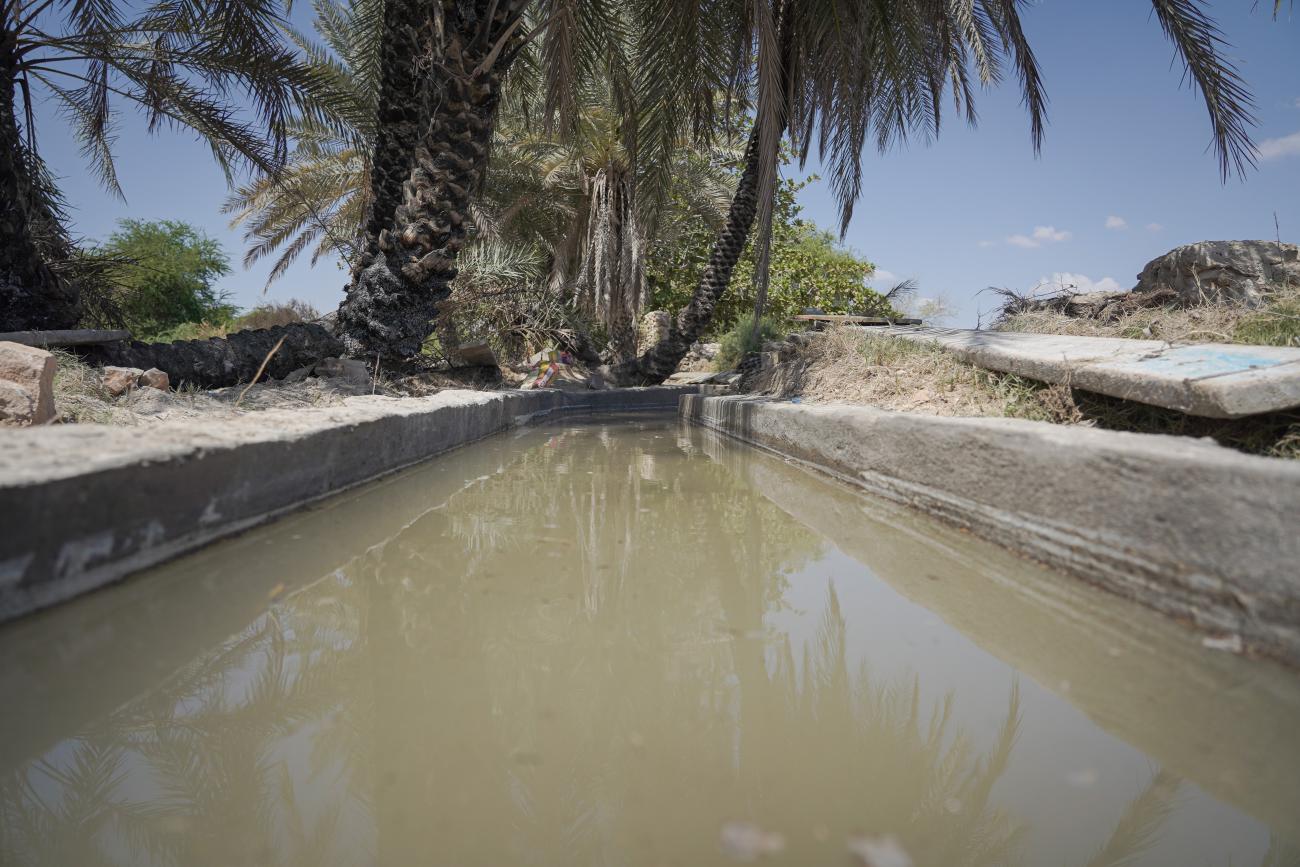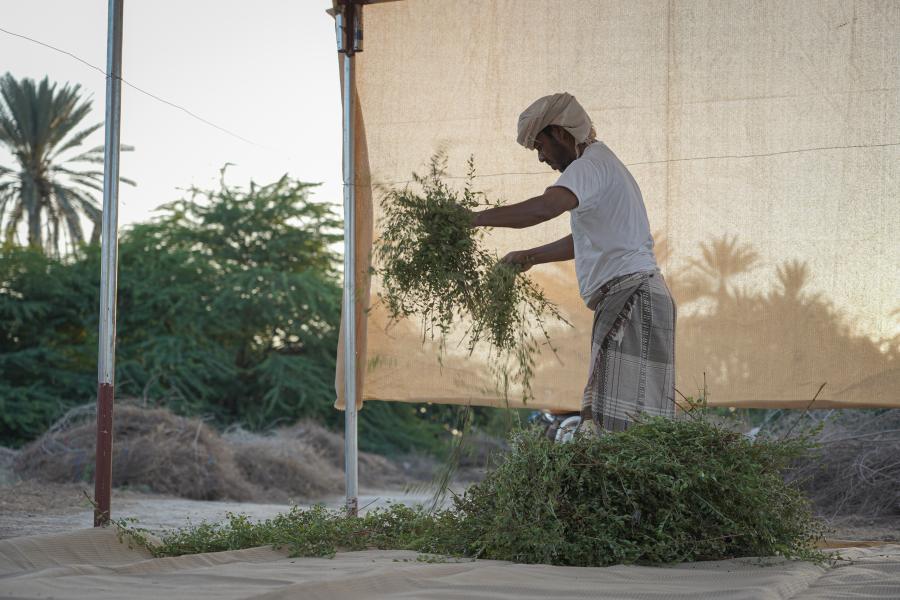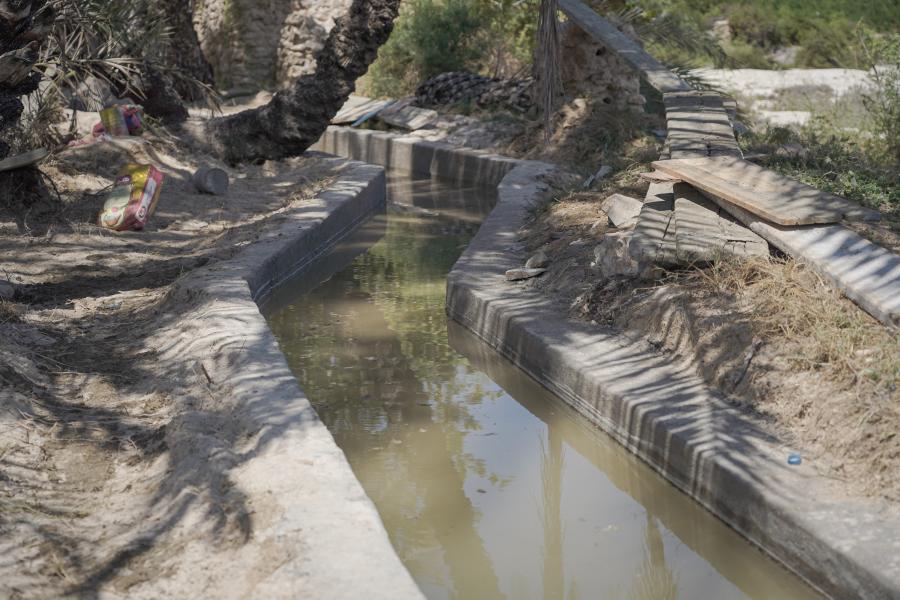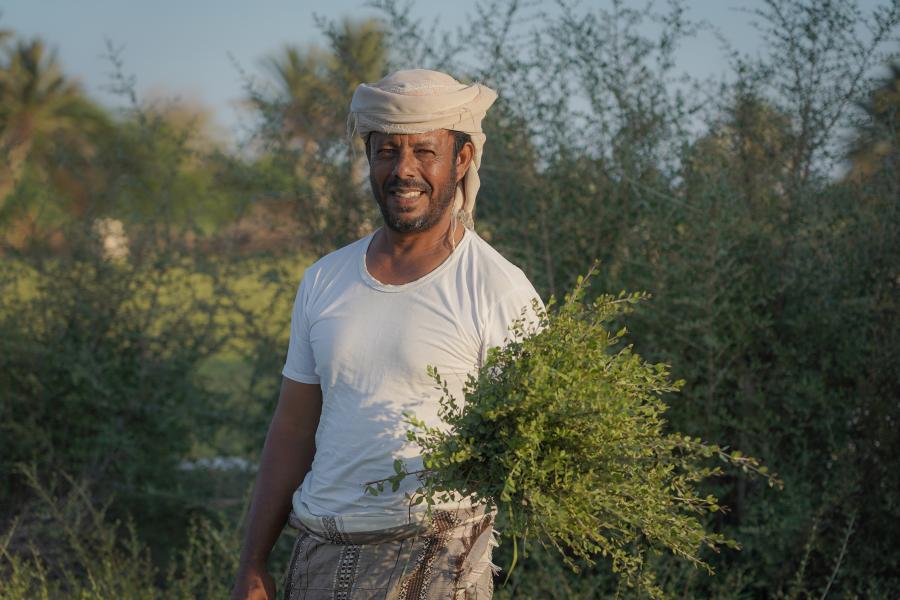RESCUING THE HENNA SECTOR IN HADRAMOUT

RESCUING THE HENNA SECTOR IN HADRAMOUT
The local authorities in the Ghail Bawazir district in Hadhramaut governorate, and its executive offices, have played an instrumental role in rescuing the henna sector – one of the district’s most famous legacies. Henna, an evergreen tree from which many traditional Yemeni beauty secrets have been derived, holds an important part of Yemeni culture.
Seeing the need for, and importance of, the henna sector, to the local economy and culture, the local Hadhramaut authorities hosted a workshop to discuss its future. Speaking with representatives from the community’s private sector, farmers, women, and youth, they worked together to select the most pressing issues associated with saving the collapsing henna sector. The team quickly set off to conduct a full assessment that looked at the challenges of the sector and they returned with proposed solutions to help it thrive once again.
The Ghail Bawazir district is 2,410 square kilometers (about 1,498 miles) and is distinguishable by the fertility of its land – due in large part to the existence of many wells and water springs. For generations, Ghail – which translates to “water running on the surface of the earth” – has been primarily agricultural land where “Ghaili Henna” has been a primary source of income for the communities.
But since the conflict erupted eight years ago, and with a significant influx of internally displaced persons (IDPs), the water supply in Ghail Bawazir has been used to supplement the scarce resources of Mukalla city. This is adversely affecting the fertility of the land and the Ghaili Henna trees that were once so abundant in the area.

PARTICIPATORY AND INCLUSIVE PLANNING
The authorities and the United Nations Development Programme’s (UNDP) project – Strengthening Institutional and Economic Resilience in Yemen (SIERY) – knew something had to be done to save not only the trees, but also the livelihoods of so many from the community.
Generously funded by the European Union, SIERY works across Yemen with local authorities to engage the local community, the private sector, and civil society to ensure comprehensive decision making and planning to reflect the needs of the community. Additionally, to help achieve and maintain results, SIERY also helps develop the local authorities’ capacities to maintain, enhance, and expand its good performance.
This is precisely what happened in the Ghail Bawazir district, where the community selected to save the Henna trees and farming by working to rehabilitate several old agricultural irrigation canals, locally known as Al-Ma’ayen – the only source of agricultural water in the district.
The canals that provided the water to the tree farms were made of dirt where 60 per cent was absorbed into the ground as it traveled for 2.5 hours to reach the Henna trees. Because of traditional farming practices, the farms needed up to 9 hours to be fully irrigated so the water pumps were working overtime to compensate to push it along the porous route. This long cycle repeated itself every 20 days with the water irrigation cycle.
In addition to tremendous time and lost water resources, the amount of fuel needed to run the pumps for hours on end was also unsustainable. The cost of the fuel was prohibitive and the Community Committee who was responsible for maintaining the canals had no additional time or money to spend to renovate them.
“Agriculture has been an instrumental sector for generations, and the particular interest in Henna encouraged us to work closely with this important project,” explains Salem Al-Ataishi Bawazir, the District Manager of Ghail Bawazir. “For a number of reasons, the henna sector has tremendous potential to expand and provide a number of job opportunities for various sectors across the district.”
SUPPORTING VARIOUS LINKS IN THE VALUE CHAIN
Translating ideas into action, SIERY worked with our local partner – the Small and Micro Enterprises Promotion Service (SMEPS) – to help ensure long-term positive impact within the community. Together, we worked to fix three irrigation canals (Al-Harth, Al-Naqa’a, and Leshwal) by using cement-coated stones laid for 2,866 meters (approximately 1.8 miles). Additionally, we provided:
- 100 farmers with quality farming materials like leaf dryers and fertilizers.
- 9 Henna mills with in-kind assets like grinding and packaging machines.
- Capacity development training in Business Continuity Management.
Furthermore, 13 women received vocational, administrative, and financial training to produce innovative and transformative henna products. They also received seed grants to start their micro-businesses.

IMMEDIATE IMPACT
In a short time, this multi-sectorial intervention had immediate impact and showed extraordinary results. Remarkably, the rehabilitated irrigational canals recovered the 60 per cent of the water loss and were able to pump water to the fields in 25 minutes instead of 2.5 hours. And because of the efficiency of the canals, the farms were able to access the water irrigation cycle every 13 days instead of 20 and full irrigation was achieved in three hours instead of nine. The reduced pumping time also significantly cut the cost of fuel for the farmers as the pumps were not pumping as long.
Now over 2,040 farmers are benefiting and – seeing the value in the rehabilitated canals – the Community Committees are looking to invest in maintaining the canals.
As for the Henna trees, the leaves turned a vivid green with the extra water and quality fertilizers. They are remarkably soft with a strong aroma and the long, full branches are plentiful. The quality of the produce has driven the price of 12 kilograms of henna from YER 8,000 (about US$ 6.5) to YER 15,000 (about US$ 12.20). The improved crops meant double the profit for the farmers and additional money for the rest of the players in the value chain as well.
The henna mills also witnessed increased operations with some notably increasing their male and women laborers to meet the increasing demands of the market. Additionally, the 13 women entrepreneurs kicked-off their micro-businesses producing henna-based products in cosmetics and skin care.
All of this will lead to increased district revenues that will enable the authorities to invest in other service projects for the community. The benefit of this project is two-fold as it will help increase local revenues as well as reinforce community trust in the local authorities to improve the service delivery levels and business environment.
Many of the farmers who received the leaf dryers and fertilizers from the SIERY project are ecstatic about their newfound skills and the modern equipment. Uncle Mubarak Ba Anqoud is one of them.
At 71-years-old, Uncle Mubarak has worked in henna farming for over 15 years and cultivates and dries the leaves before selling them. He received both the leaf dyers and fertilizer for his henna trees and remarks that “The fertilizer softened the soil and enhanced the smell of the henna trees.” He noted that after so many years, it was incredible to see how the trees had sprung back to life. Uncle Mubarak also enjoys the cleanliness and efficiency of the dryers, commenting that “they protect the leaves from sunlight, dust, and impurities.” This ultimately helps increase the amount that he can sell the leaves for in the market.
Seeing the successes of the SIERY project, some of the other local farmers even indicated that they may be willing to forego their crops in tobacco – another famous Ghail Bawazir crop – to begin to grow henna trees. Additionally, some farmers who did not participate in the SIERY project are beginning to adopt and implement the same work modalities to develop their farms and corps and to increase their income and profit.

FOOTNOTES
Funded by the European Union (EU) UNDP’s Strengthening Institutional and Economic Resilience in Yemen (SIERY) project has been designed to buttress the resilience of local governance systems in Yemen to reinforce the resilience and recovery of conflict-affected communities. The project is based on the assessment that in a context of protracted conflict and massive population movements across the country (disproportionately affecting women, children and youth), that the resilience of local populations cannot depend solely upon self-help or on foreign aid. It is also necessary that local authorities are able to more effectively fulfil their mission in terms of: (a) core functions, (b) basic service delivery, (c) emerging needs such as conflict resolution, humanitarian aid, disaster management, internally displaced people and (d) economic recovery.




